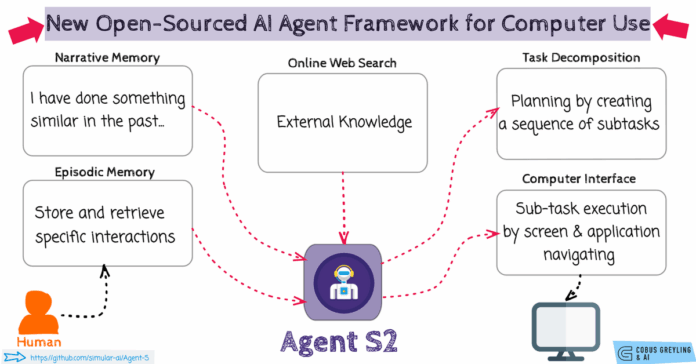Introduction to Agent S Architecture
The Agent S architecture is a complex system that enables AI agents to interact with desktop environments. The core components of this architecture include the Manager, Workers, and Agent Computer Interface. The Manager handles memory, planning, and web knowledge retrieval, while the Workers execute subtasks and generate specific actions. The Agent Computer Interface interacts with the desktop using bounded actions, ID-grounding, and OCR.
How Agent S Works
The flow of Agent S shows how a user task moves through the system, from planning to execution to desktop interaction, with feedback loops for learning from experience. This process involves the Manager, Workers, and Agent Computer Interface working together to complete tasks. The recent innovation in computer use AI Agents is enabled by advancements in Multimodal Large Language Models (MLLMs), such as GPT-4 and Claude, which have laid the foundation for the development of GUI agents for human-centered interactive systems like desktop OS.
Challenges of Working with Applications and Websites
Working with applications and websites poses several challenges for AI agents. These challenges include:
- A vast range of applications and websites that constantly evolve
- The need for specialized domain knowledge that must be up-to-date
- The ability to learn from open-world experience
Challenges of Complex Desktop Tasks
Complex desktop tasks also pose significant challenges for AI agents. These challenges include:
- Long-horizon planning
- Multi-step execution
- Interdependent actions that must be executed in specific sequences
GUI AI Agents and Changing Interfaces
GUI AI Agents must be able to work with changing and diverse interfaces by:
- Processing lots of visual and text information
- Choosing from many possible actions
- Identifying what’s important and what’s not
- Understanding graphics and symbols
- Responding to visual feedback while completing tasks
Key Components of Agent S
Important components to note are the web knowledge component, which provides a flexible source of data, and the manager component, which holds the narrative memory, planning, and sequencing the subtasks, as well as the experience context component. These components work together to enable the AI agent to complete tasks and learn from experience.
Conclusion
In conclusion, the Agent S architecture is a complex system that enables AI agents to interact with desktop environments. The challenges of working with applications and websites, complex desktop tasks, and changing interfaces require AI agents to be able to learn from experience, process visual and text information, and understand graphics and symbols. The key components of Agent S, including the Manager, Workers, and Agent Computer Interface, work together to enable the AI agent to complete tasks and learn from experience. As AI technology continues to evolve, we can expect to see significant advancements in the development of GUI agents for human-centered interactive systems like desktop OS.

